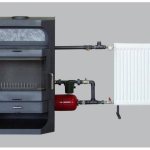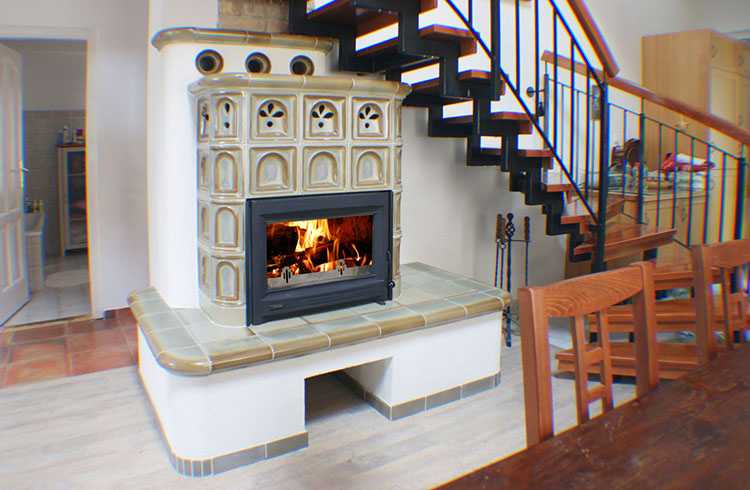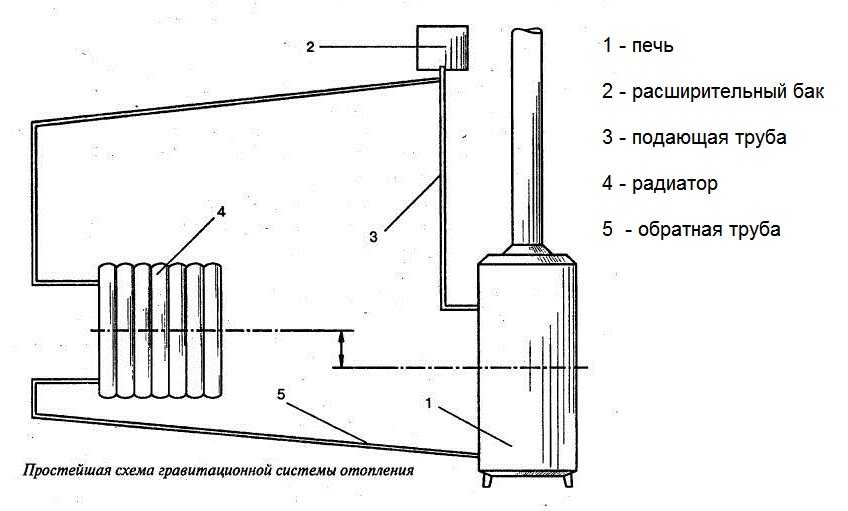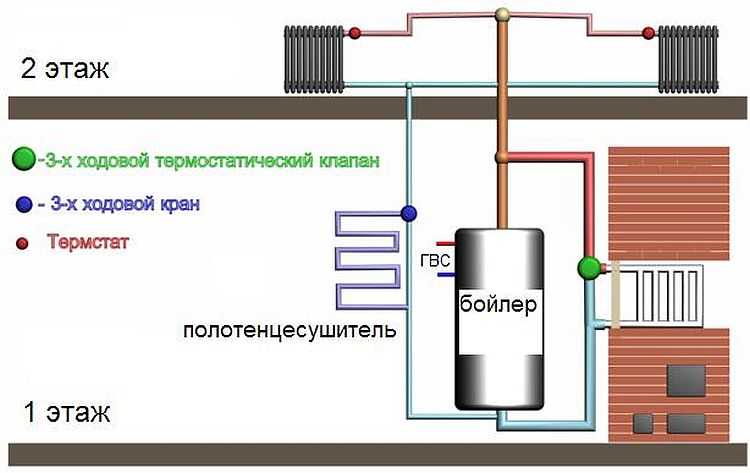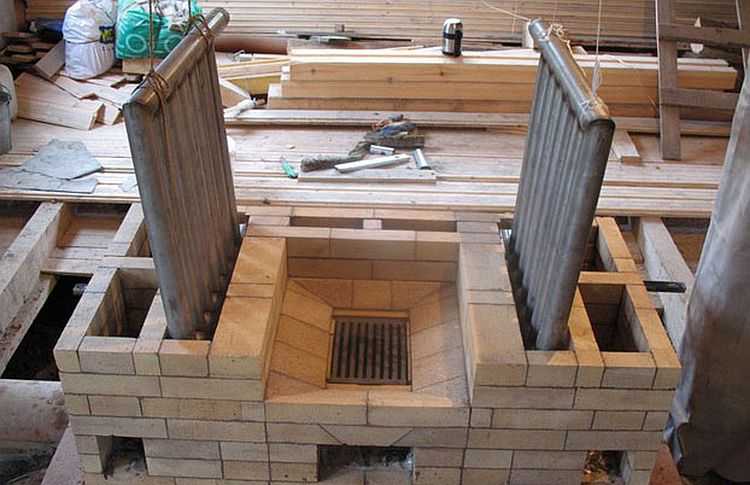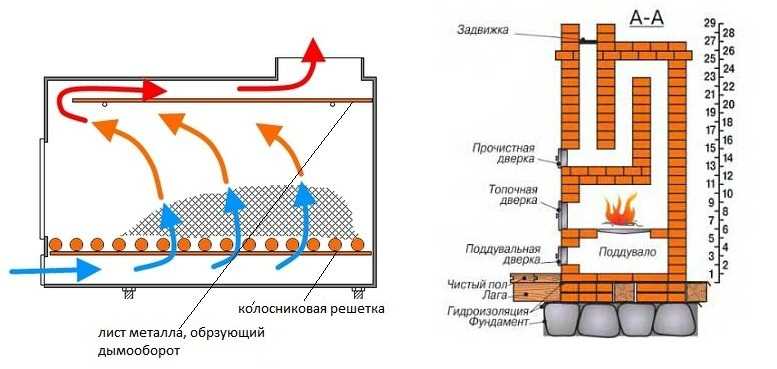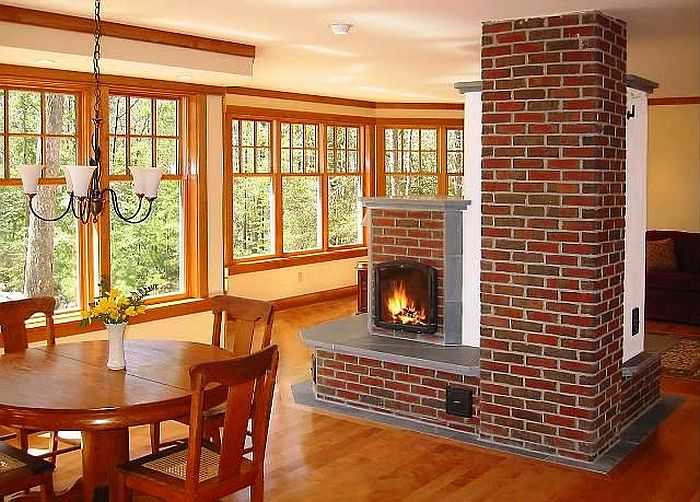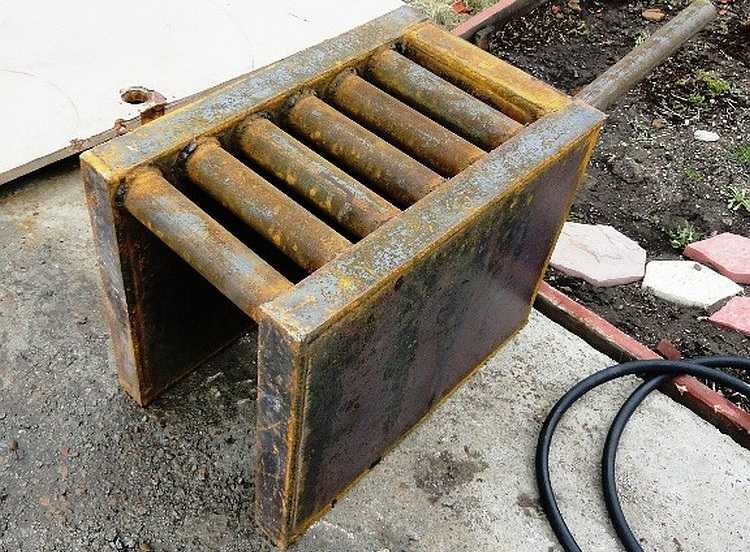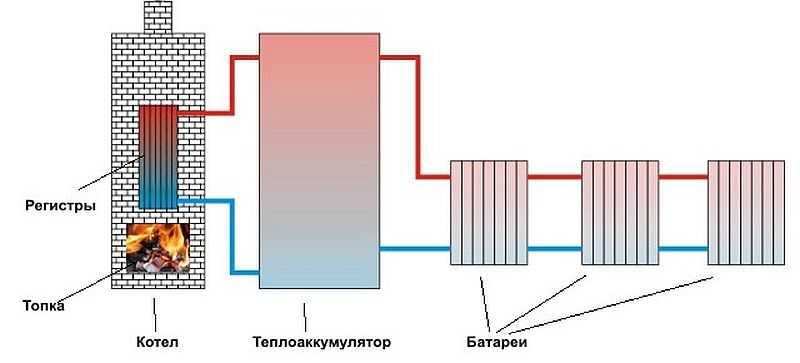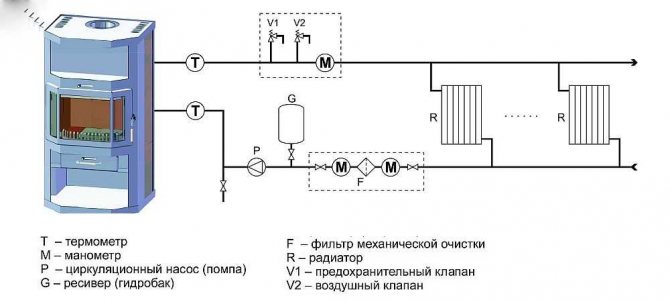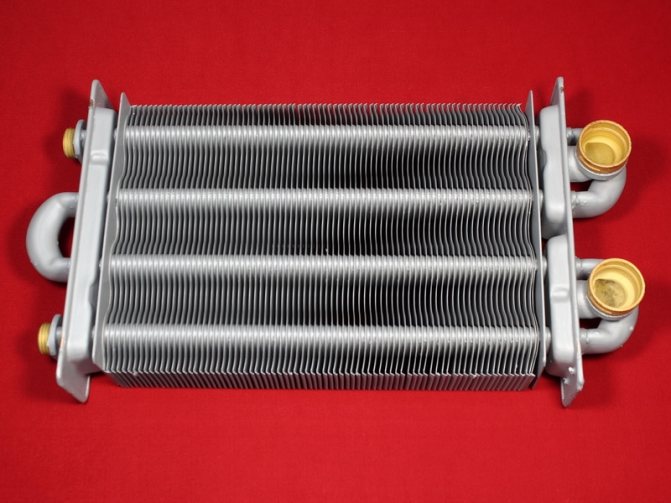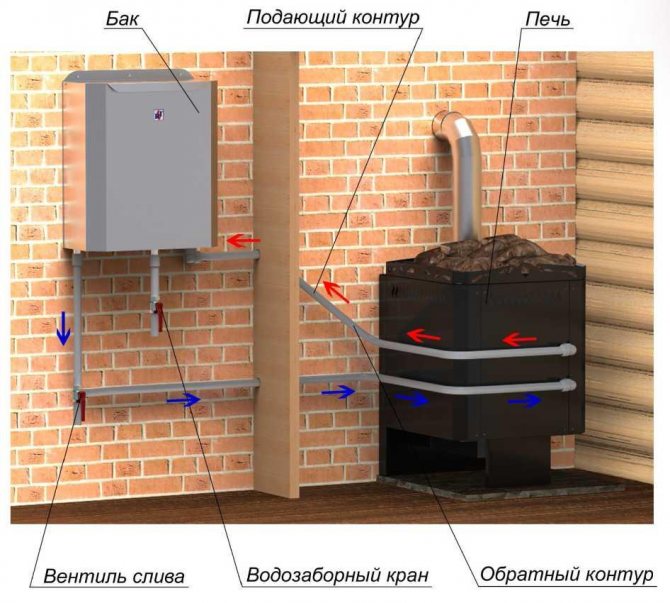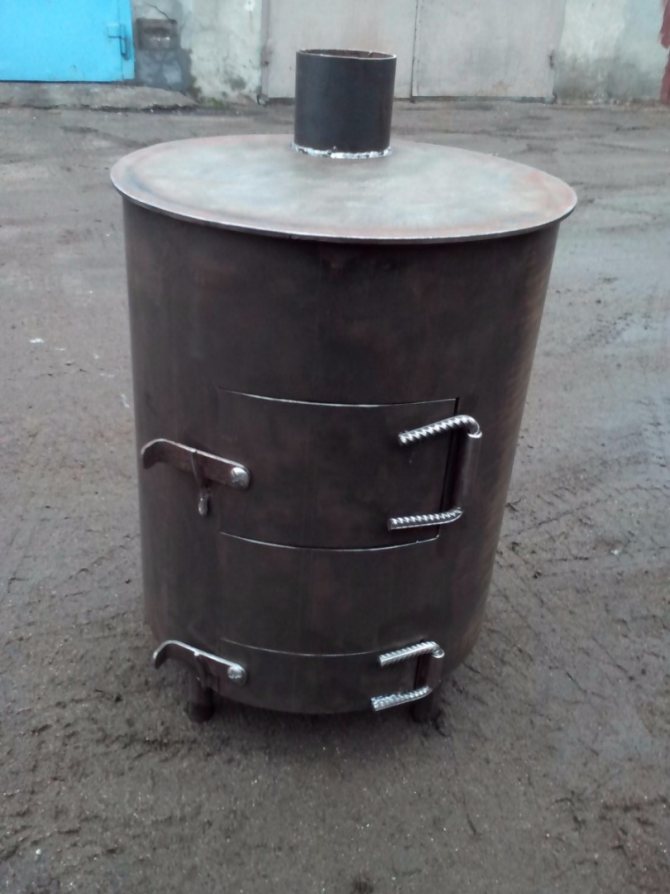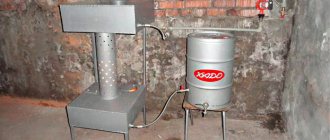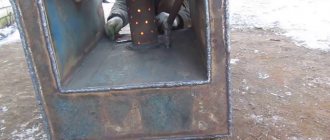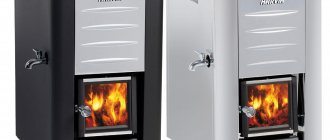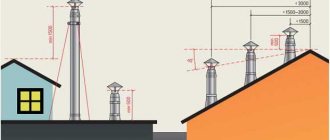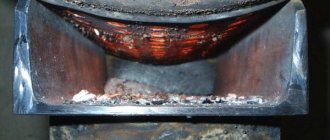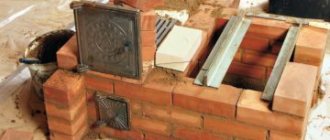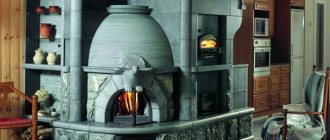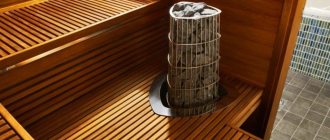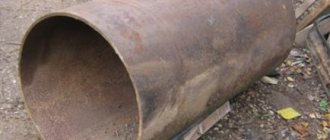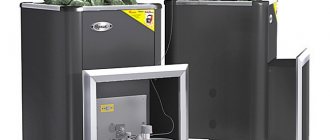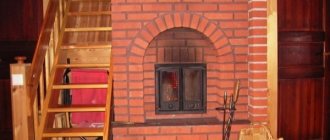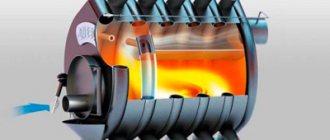The main building material for furnace equipment is most often metal or high-strength brick... When laying the foundation for this structure, the fact that the latter material is much heavier than metal, therefore, requires the construction of a reliable foundation, has a significant impact.
When constructing a sauna heating stove, it is recommended to use a special durable material with refractory properties, for example, fireclay bricks. In this case, a silicate block will not work, since it is prone to deformation due to exposure to high temperatures.
Device
In fact, almost any wood stove, even an old brick stove, can be converted and supplied with a water circuit. Nevertheless, it is better to give preference to ready-made solutions with a well-arranged structure, where the heat exchanger is inscribed harmoniously and does not spoil the combustion process and traction.
The idea is to place a water heat exchanger directly in the combustion chamber or in front of the chimney. Depending on its design and location, it is possible to organize radiator heating throughout the building.
There are five main types of heat exchangers:
- coil;
- register of pipes inside the furnace;
- built-in boiler, storage tank;
- pipe register on the outer wall of the oven, convection;
- chimney heat exchanger.
Coil
+ Simple execution.
+ Maximum heat dissipation.
- Forced circulation only.
Inside the furnace, often at the entrance to the chimney, there is a plate heat exchanger, approximately the same as installed in gas boilers. Due to the hot air and combustion products, the coolant is heated. Since there is no natural convection of liquid in this case, and for circulation in the heating system, it will be necessary to install a circulation pump. This already makes the heating dependent on the availability of electricity.
Register of pipes inside the furnace
+ Fast heating.
+ Simplicity of design.
- Weak heating regulation.
A tubular direct-fired heat exchanger is formed inside the combustion chamber. A number of "П" -shaped pipes installed parallel to each other and united by two collectors, respectively, inlet and outlet. The heat from the fire and smoldering wood heats the coolant in the pipes. A rather risky option, since in the absence of circulation, the coolant boils. If there is no additional volume for expansion and removal of vapors, a burst of the heat exchanger is possible. However, this is the simplest and most affordable option for self-execution and alteration of an existing wood-burning stove. In stoves originally equipped with such a register, a heat regulator is installed, which, depending on the heating of the water, adjusts the position of the damper, reducing the activity of burning wood.
Boiler
+ Heat reserve, high inertia.
- Strong influence on the combustion process.
The storage tank is formed directly on the sides of the firebox and additionally on top. It is a direct alternative to the pipe register, only the heat exchanger is formed from sheet steel. In fact, the structure forms the main walls of the furnace itself. Replacing, for example, brickwork. Disadvantages are similar to the previous option. The advantage is more active convection and the ability to organize a heating system with natural circulation of the coolant. It is only important to provide cold water supply at the lowest point of the heat exchanger and hot water intake at the highest point.
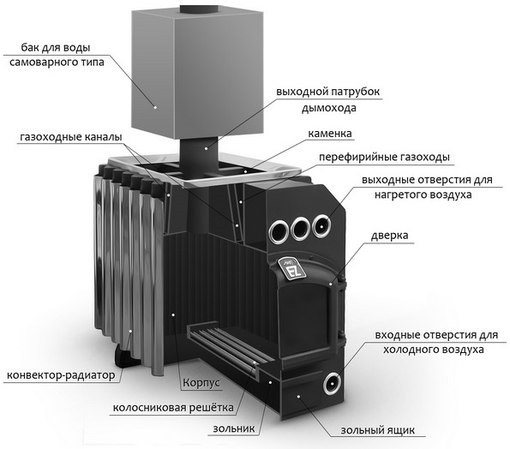
Butakov's furnace with a boiler and a water circuit
Register of pipes along the furnace body
+ Good heat transfer.
+ Smooth heating.
+ Ability to regulate the temperature of the coolant.
+ The water circuit has little effect on the combustion process.
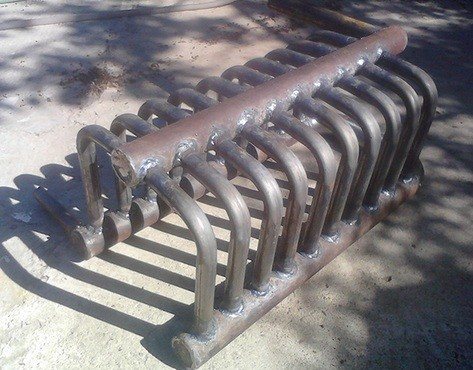

The convection type is typical for most modern wood-fired ready-made stoves. A register of shaped pipes is formed along the perimeter of the furnace, and also partially along the chimney channel from the outside of the main body of the furnace. The best option for organizing heating with natural circulation and with minimal risk that the coolant will boil.
Chimney heat exchanger
+ Simplicity of design.
+ Compatible with any oven design.
- Has a negative effect on traction.
A chimney heat exchanger is a special case for organizing water heating based on a stove that is not equipped with a built-in heat exchanger. This is more often a cylindrical tank, fixed to the chimney so as to grip it around the perimeter. The water is heated by the heat of the gases emanating from the firebox. There is also a variant with a coil wound around the pipe. The first option is suitable for natural circulation heating, in the second case a pump is required. Both options are bad in that they significantly lower the temperature of the walls of the chimney, causing condensation and rapid clogging of the chimney.
The difficulty in designing a water circuit in a furnace is a strong heat removal from the combustion chamber or chimney. Due to this, the combustion temperature and, most importantly, the heating of gases can be significantly reduced, which affects the magnitude of the thrust. This is especially true for long-burning furnaces with a water circuit. Not only do they create a weak draft by themselves, heat removal can stop the smoldering of wood and thereby cause a dangerous situation when the stove dies out or, even worse, the draft collapses, and carbon monoxide, along with unburned flammable gas, will begin to flow into the room.
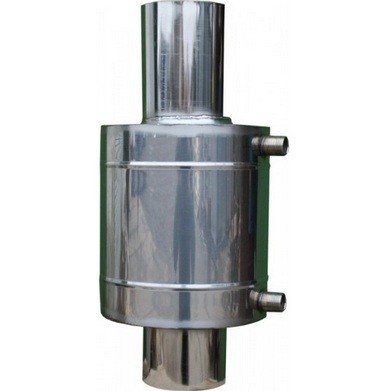

The main disadvantage of furnaces with a water circuit is the inability to regulate the temperature of the coolant and turn off the heating during the operation of the furnace. If the wood is already burning, then circulation must be maintained in the heat exchanger, otherwise the water will boil, and the metal will break from the excess pressure, and the stove will deteriorate, as will the interior situation in the house.
The problem is partially solved for external registers and plate heat exchangers. External convectors are capable of working as an air convector even without being connected to the heating system or quickly enough to dump the heat coming from the firebox. In the case of a coil and plate radiator, it can be positioned so that it is possible to shut off the flow of flue gases through it.
Preparation of components
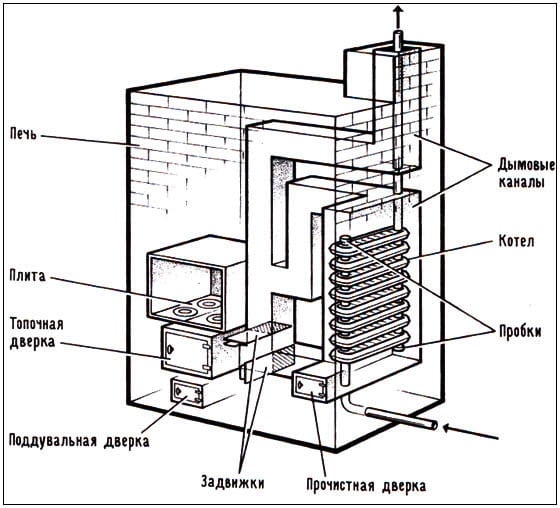

The material for the manufacture of a heater depends on its future shape. If the drawings provide for a device round shape, then you can use a metal barrel or a large radius pipe. And if it is supposed to make rectangular oven, then it is necessary to prepare metal sheets, the thickness of which is not less than 5 mm... The equipment consists of two zones: furnace and combustion products outlet.
To use large firewood, you need to make a hole with a cross section like minimum 40 × 40 cm... If you plan to heat the room with coal or small wood, then the hole can be made with a cross-section, about 20 × 20 cm... It is recommended to build a flue gas vent at the rear of the structure. At the same time, during assembly, it is necessary to install the chimney at an angle. not less than 30 degreesto ensure optimal traction. Otherwise, all the smoke will be enter the dwellingwhich is heated.
The side ribs of the heated device increase the heat capacity of the furnace. To achieve this, it is necessary to prepare metal plates with a thickness not less than 5 mm... They need to be welded on the sides of the equipment perpendicular to the planes of the barrel. As a result, the heating surface will increase, which will lead to an increase in heat transfer. Some experts are covering the stove with red bricks in order to keep warm for a long time and ensure additional fire safety.
For a bath
For a bath, the main emphasis is on the heating rate. The stove is used sporadically and it is necessary to quickly heat the room. Water is needed to heat the dressing room using classic radiators or warm skirting boards and, possibly, for the underfloor heating system.
You can use any option with the exception of the boiler, which, by definition, picks up the temperature for a long time. Taking into account the active combustion of firewood in the heater, even a heat exchanger for the chimney is relevant. The temperature of the gases is more than enough to maintain traction and heat the coolant.
In this case, it is impractical to organize heating with natural circulation, when the steam room is already ready in the bath, the heating will just start to warm up. Variants with extremely high heat transfer rates are not suitable.
It is easier and more efficient to install a pump and pump the coolant through radiators and floor heating pipes, build heating to use the coolant temperature in the range of up to 60 ° C and no higher.
Installation of a water jacket in the furnace device
The basis for this kind of heating structure is a heat exchanger, for the creation of which one of the following materials is needed: sheets of steel or cylindrical steel pipes. In addition, for the process of creating a potbelly stove with a water jacket, it is necessary to prepare:
- a ready-made array of the future potbelly stove;
- pipes;
- metal sheets;
- radiators.
The installation process is as follows:
- At the top of the furnace structure, it is necessary to make two backlashes required for the supply and return of water.
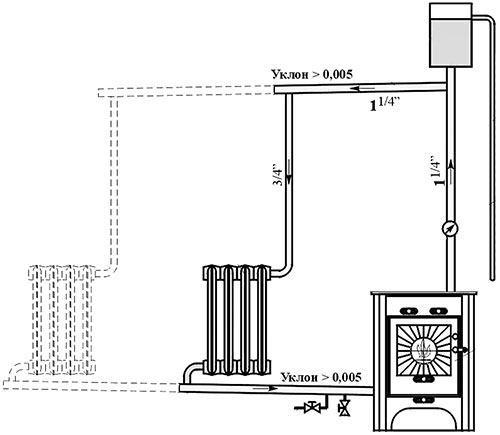

[Photo 5 To make the correct design, it is necessary to draw up a diagram of the assembly and connection of a potbelly stove with a water jacket.]
- Any metal structure can be used to create a water tank. The tank should occupy the largest area in comparison with the ash pan and firebox. The necks for the nozzles are cut in the tank, after which it is installed behind the firebox. The site is divided by a sheet of metal.
- After that, the installation of the collector, one- or two-pipe wiring is played.
It's important to know! The most relevant option is two-pipe wiring. This model is more efficient due to the presence of control valves and ensuring uniform heating of the furnace structure. To reproduce the collector wiring, which is the most difficult, certain knowledge and skills will be required.
- This is followed by the stage of sequential connection of pipe adapters with radiators located in the room.
For home
The house needs heating for the entire cold period of the year, so proposals related to moderate and constant maintenance of the coolant temperature come to the fore.
The principle of building a heating system is identical to that of solid fuel boilers. Preference is only given to a closed design with an expansion tank and a low pressure in the system not exceeding 2 atm., Which should be coordinated with the permissible pressure of the water circuit in the furnace.
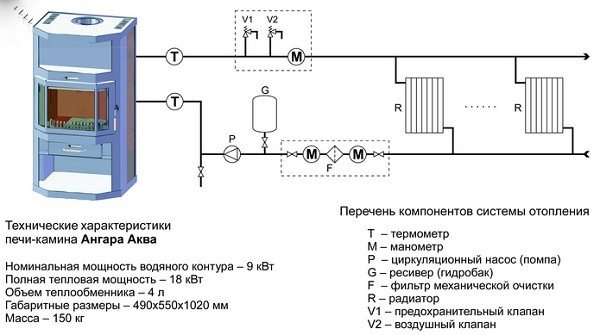

Diagram of the organization of heating a furnace with a water circuit Hangar Aqua
conclusions
To save money, you can make a potbelly stove with your own hands. This will allow you to endow the garage with warmth even in severe frost.
One of the most important aspects of a city's life support is its heating system. In private sectors, its formation is carried out using an oven structure.One of the most relevant options is a potbelly stove with a water circuit, working by means of radiator batteries, which is sufficient to heat the whole house as a whole. The high cost of such heating structures often encourages the independent manufacture of a water heater.
Advantages and disadvantages
The oven, which has a heating cavity, is designed in such a way that flammable vapors envelop the container on each side. This helps to maintain consistently high temperatures. In addition, the distinctive features of the potbelly stove are:
- good performance;
- the cost of construction and use is much more affordable in comparison with other heating systems;
- it is permissible to create a stove from waste materials - this helps to save money;
- suitable for ignition - coal, various vegetable waste, firewood;
- no connection to a power source is required;
- functioning thanks to natural circulation.
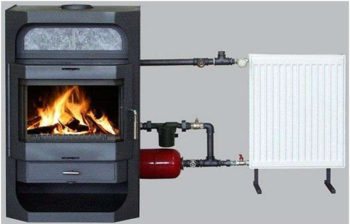

Pros of having a contour
How to make a potbelly stove with a water circuit
For heating several rooms or premises with a potbelly stove, the stove, first of all, must be made of durable, reliable material. Ideally, consider a material such as sheet steel or masonry.
At the first stage of construction, it is necessary to develop a sketch of the drawing. First, for this, it is worth deciding on the placement of the oven. With the help of a tape measure and other measuring devices, it is necessary to take measurements, after which the dimensions of the structure itself will be calculated. These measurements will form the basis of the drawing.
When the drawing is ready, they start marking the foundation and laying it.
In order to perform laying under the foundation, it is necessary to disassemble the floor slabs and dig a rectangular pit 40-50 cm deep. The bottom of the pit is filled with rubble, which can be small brick chips, crushed stone, sand. The buta mixture is poured with cement, while it is important to keep the pouring horizontally by checking it with a building level. Several layers of roofing material are laid on the dried layer of cement, which serves as a waterproofing agent and a material that prevents the influence of moisture from the soil on the furnace structure.
System features
When installing a water heated floor in the bath, operating from a wood-burning stove, there is no need to install a boiler. However, a heat exchanger must be built above the firebox. Any stainless steel tank that is not prone to corrosion is suitable for this. A contour is extended from it into the room where the warm floor will be mounted.
To return the waste fluid to the tank, you will need to install a small pump. Without it, the structure will work only when the stove is located below the level of the floor covering. With this scheme, the pipe diameter should be taken equal to 16 mm, ordinary 24 mm ones will not work.
The main feature of the oven floor design is the lack of the ability to adjust the temperature level. The recommended temperature of the underfloor heating in the bath is 40 degrees, from the oven the coolant will be heated to boiling water.
Therefore, it is required to make a mixing block in which hot water will be mixed with already used water, thereby reaching the desired temperature level.
Since it is not possible to install a large capacity in the furnace, you can place an accumulator tank near it, and stretch steel pipes from it to the heat exchanger.
Exploitation
The potbelly stove is used taking into account some features:
- The chimney must be brought out into the street - through the ceiling or wall. It is forbidden to connect the pipe to ventilation. Crossing areas must be securely insulated with non-combustible materials.
- Modern designs of metal stoves, when properly assembled, can qualitatively heat one room with an area of up to 30 square meters.But the garage must be well insulated.
- If the heating area is more than 30 m 2, the organization of the circuit is mandatory.
- When there is a potbelly stove with a contour in the room, you should always have a box of sand and a container of water ready.
- It is necessary to equip a separate place for storing firewood to the stove, since their consumption will be rather big.
- Compliance with all operating and fire safety installations will keep the property intact and safe.
Care rules
The stove will serve for a long time, provided that the owners follow the rules for caring for the equipment. These include:
- Opening the condensate trap daily to drain the water. It is placed on the chimney.
- Before starting the heating season, the chimney is well cleaned of the soot that has settled in it with the help of special tools.
- During operation, the stove body and chimney are regularly inspected to prevent exhaust smoke from entering the garage.
- It is important to constantly monitor the condition of the hood and supply ventilation.
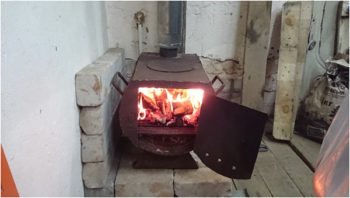

Recommendations for the care of the structure
Self-construction of a metal wood stove is not only effective. With the right approach, such a stove becomes a real decoration of the room. But the main thing is to follow all the rules of construction, maintenance and operation.
Application area
Wasted heat can be used for two purposes:
- to heat the water to be used for washing;
- for space heating.
Of course, such goals can be combined if the stove is powerful enough. After all, we, in fact, will take away some of the heat that would otherwise be used to heat the steam room (or the atmosphere)).
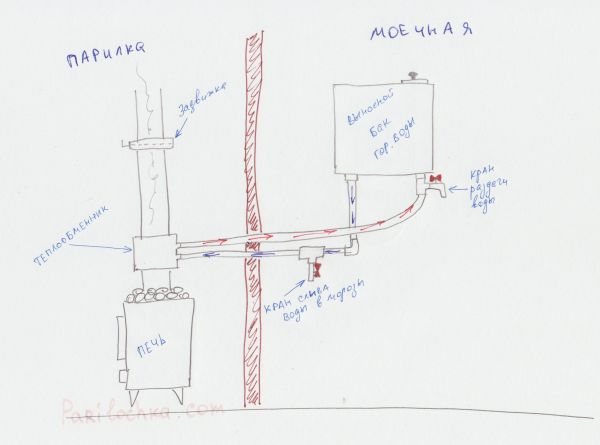

Scheme of heating water in a remote tank with a samovar-type heat exchanger (for a video explanation, see below)
This is the first time. We are talking exclusively about water (no antifreeze), the consumption of which depends on the number of people who can wash in the bath at the same time and other factors. In any case, you cannot do without a spacious tank. And here you again have options for where to place it:
- some place the tank directly on top of an oven, which must be designed accordingly. Water is supplied to the washing room from the steam room;
- others use a heat exchanger, and the tank itself is placed in an adjacent room, from where it communicates with two pipes with a heat exchanger.
Both designs of stoves with a tank have the right to exist, and the choice is yours.
If, instead of a tank, you connect a heat exchanger with a radiator, you get an autonomous heating system.
And here you again have two options):
- or create a structure that is based on phenomena such as convection and gravity;
- or to force the coolant to move forcibly in the system - this will require a pump, and therefore electricity (! a separate section is devoted to electric stoves).
If the bathhouse is small, then there is no need to bother even with the simplest system, because usually the stove is enough to heat adjacent rooms. But what matters here is what kind of winters you have. It happens that a small bathhouse needs additional heating.
It was already mentioned above that it is possible to combine heating water for washing and heating. In fact, you can make two parallel systems, and for heating not water, but antifreeze. For this purpose, one heat exchanger will need to be placed inside the furnace, and the second on the chimney. From the point of view of increasing the efficiency of the furnace, the option is just excellent.
On a note! When creating a heating system, do not forget about the expansion tank, which will take over the excess coolant.
How can the dressing room be heated?
There are several options for heating the dressing room from the stove:
· Installation of a sauna stove between the dressing room and the steam room. In this case, the firebox goes into the dressing room, and the tank is installed in the bathhouse. The dressing room is heated from the heat of the firebox itself.This option is the least expensive, however, it requires the installation of the oven in the wall, which entails the need for the construction of a heat-resistant coating. In addition, the dressing room will be heated rather weakly compared to other heating methods.
· Creation of a steam heating circuit. This method allows you to heat the dressing room immediately after firing the stove - the steam from the convector will spread through the pipes, heating them and quickly warming the room. The disadvantages include the need to spend more fuel for heating than when using a water circuit. The steam room itself will heat up a little longer.
· Use of a water circuit. It is the most difficult and cumbersome to install, but the most energy efficient method - water quickly heats up from wood, heating the dressing room. The disadvantages include the complexity of construction and the need to monitor the temperature in the room - without using an anti-freeze coolant in winter, the system can freeze and the pipes can burst. At the same time, the steam room will warm up longer, because part of the energy will go to heating the water.
The best option is steam heating with the construction of a convection circuit. To build it, you need a furnace with the ability to install a steam heat exchanger and the ability to create a system of pipes through which steam will move.
The main elements of the system are the furnace heat exchanger, pipes and a condensation tank - cooled water will drain into it. The system is mounted with a slight slope, which allows for the movement of cooled water.
Please note that a furnace with a heat exchanger will be required to create a system - installing it separately can be expensive, especially after installing the furnace itself. The pipes themselves and the condensation tank can be installed at any stage, even after the construction of the bath is completed. It is important to empty the tank after each use, otherwise it will freeze and the tank will burst.
Material selection and tool preparation
Materials for the manufacture of a potbelly stove are required as follows:
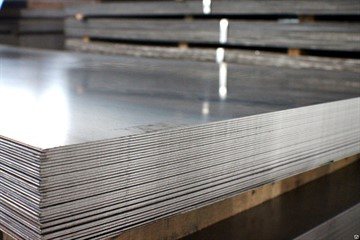

- body: steel sheets 5 mm thick;
- chimney: pipe with a wall thickness of 3 mm;
- legs: any metal, for example, a corner, profiled or round pipe, etc.;
- water heating tank: steel sheets 3 mm thick;
- oven doors with hinges.
A set of tools required:
- grinder with several cutting discs for metal (diameter of the working part - 125 mm);
- a welding machine designed for a welding current of 200 A;
- a hammer;
- pliers;
- metal brush.
The choice of form and components
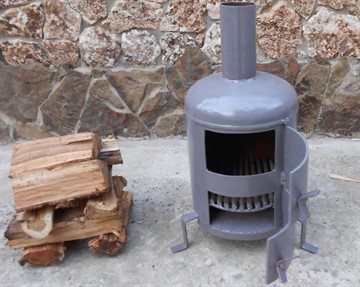

Potbelly stove is usually made of steel sheets in the form of a rectangular box. You can use a gas cylinder, but not a narrow industrial one, but a wide household one. The cylinder should be placed vertically, since the stove is designed for flat vaults and under.
In a horizontal orientation, rounded surfaces will collect flue gases into a bundle, for the afterburning of which the length of the "hog" (see below) will have to be increased to 12 m.
In addition, to ensure the normal operation of the stove, you will need a chimney and a screen.
Chimney
The throughput is slightly less than the combustion product performance of the furnace. Due to this, gases are retained, circulating in the firebox.
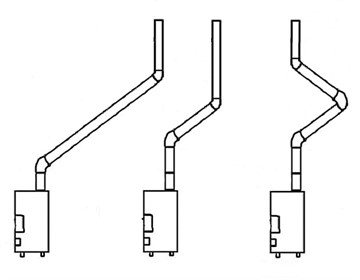

The effect is double:
- combustion products give off more heat;
- due to their circulation, air is sucked in and this ensures complete combustion of the fuel.
To comply with this condition, the pipe diameter is calculated by the formula D = (2.5 ... 3) V, where:
- D - pipe diameter in mm;
- V - volume of the firebox in liters.
Preparatory work before assembling the heater
The potbelly stove is a source of increased fire hazard. Therefore, placing it in the corner of a room or near a wall, it is necessary:
- Hang protective screens on the oven.
- Raise it from the floor, and protect the floor under it near the doors of the firebox and ash pan with tiles or asbestos slabs.
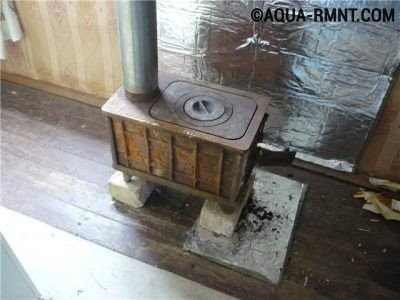

The walls and floor in the place where the stove is installed must be protected with fireproof materials, and the stove itself must be raised on a heat-insulating base
The removal of heat by the water circuit from the boiler core lowers the combustion temperature and reduces the heat radiation of the furnace. The heat exchanger affects the combustion process like a bucket of water on a fire. A cold zone of the recuperator appears inside the furnace, which does not allow the fuel to completely burn out, causing the formation of soot in the chimney and smoke above the chimney. The potbelly stove will constantly smoke.
Required materials and tools
To make a temporary stove, you will need the following tools and materials:
- Bulgarian.
- Electric or gas welding.
- Electric drill and drill.
- Locksmith tools: pliers, hammer, file, sanding paper, ruler, tap.
- Plumbing: American fittings, nuts for fittings, articulated taps, adapters.
- Sealant or silicone for fittings.
- Alloy steel sheet metal.
The following can be used as a basis for the manufacture of a furnace:
- Metal barrels with a volume of 20 to 200 liters.
- Car disks from 2 pcs.
- Propane or carbon dioxide cylinders.
- Thick-walled metal pipes with a diameter of 150 to 350 mm.
- Metal flasks for water for 20, 30 or 40 liters.
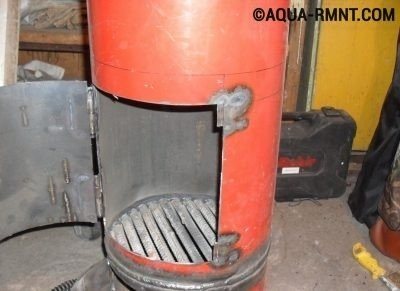

One of the most popular solutions for making a potbelly stove with your own hands is reworking an old gas cylinder
If these materials are at hand, then 2/3 of the design of the future stove is already ready. It remains only to collect everything into a single device.
Manufacturing of a heater and the device of a main boiler on a stove chimney
We select the available material for the manufacture of the device. We take into account that for an aluminum recuperator, the material needs twice as much as for a copper one due to the properties of thermal conductivity. To install a furnace with a heat exchanger 500 mm high, you will need:
- Copper or aluminum tube with a diameter of 16 mm and a length of 50 m.
- Gas cylinder or compressed gas cylinder.
- Chimney pipe with a diameter of 150-210 mm.
Features of a sauna stove with a heat exchanger
A sauna stove equipped with a heat exchanger has certain design features.
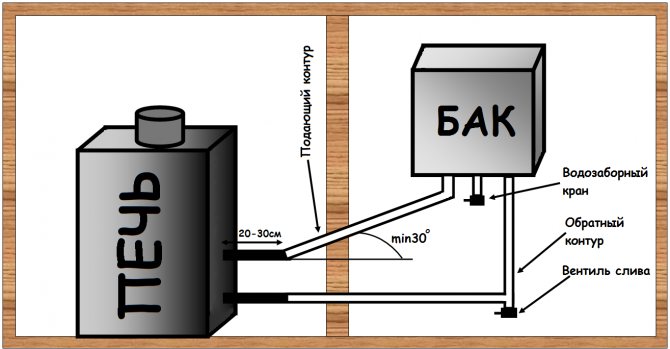

These include, in particular:
- tube supply system for coolant circulation;
- thickened body walls;
- increased volume of the heater;
- the presence of a mandatory air distributor;
- firebox door made of heat-resistant glass.
The heat exchanger functions due to the constant circulation of water through all the devices that make up the heating and heating system in the bath. For efficient use of the heat exchanger, the length of each of the connecting pipes should be a maximum of 3 m. Especially in the absence of external thermal insulation of the pipe.
Subject to the rules of fire safety, as well as in the presence of forced ventilation and thermoregulation systems, a heat exchanger can be equipped with a universal stove for a bath and home heating. The stove itself can be located in the bathhouse and connected to the living quarters of the house using a heat-insulated heating pipeline and hot water supply to the home.
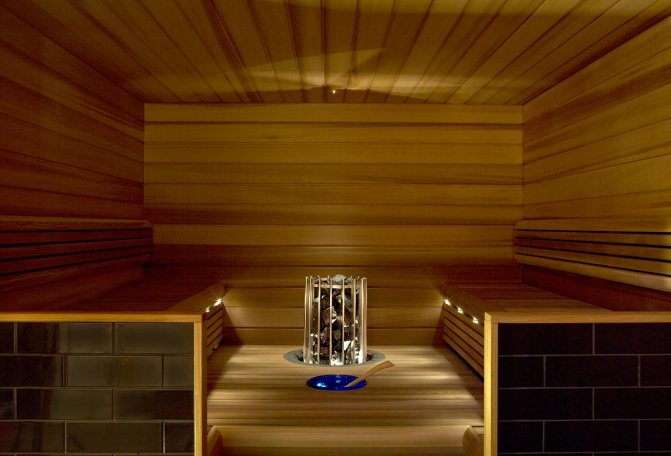

To organize the circulation of water in the centralized heating system, as well as to supply hot water to the premises of the house and to the washing section of the bath, an automated pumping station is used to maintain a constant pressure in the line.
The simplest design of a universal stove is an electric stove with separate electric heaters for the heat exchanger and heater sections.
Such a furnace can operate in several modes, namely:
- In the mode of heating the residential premises of the house and its hot water supply (DHW) with the maintenance of the minimum required temperature in the premises of the bath in the cold season.
- In the heating mode of the bath and the whole house with hot water supply during the cold season.
- Organization of heating a bath and a heater in the summer.
Cutting out the material and assembling the stove
The dimensions of the walls of the case are selected taking into account the following requirements:
- the height of the firebox is 1.3-1.5 times less than the depth;
- the depth of the firebox is twice the width.
In the front wall, openings are cut out for the combustion door and the blower.
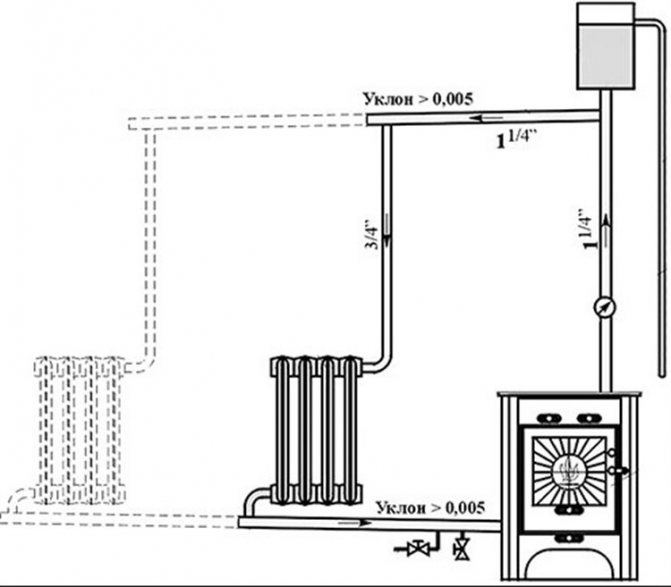

Drawing of a future potbelly stove with a water circuit
The manufacture of the furnace is carried out in the following sequence:
- corners are welded to the side walls - supports for the grate;
- a lower horizontal partition is welded to the front wall of such a length that it does not reach a few centimeters to the rear wall. This solution makes the smoke path winding, lengthening it (analogous to the smoke channels of a channel furnace). Thanks to this, the gases have time to give off more heat before they enter the chimney;
- an upper horizontal partition is welded to the back wall of such a length that it does not reach the front wall;

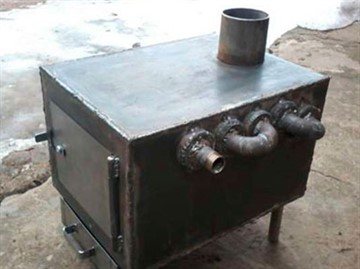
assemble the body by welding: front and back walls, top panel, bottom. At this stage, the partitions are welded to the sides. When properly assembled, the smoke flows from the firebox into the channel along its rear side, then follows to the “facade”, bends and again flows towards the rear wall and from there into the chimney. The flue gas pressure in the bend of the channel in front of the stove is lower than atmospheric pressure, therefore, a hob can be installed above this place in the lid - smoke will not leak through it. The second burner is allowed to be installed if the head rises above the roof ridge by at least 1.5 m, and an aerodynamic umbrella mushroom is installed on it;- from above to the furnace, a chimney section with a length of 1-1.2 m or more is welded vertically. Upon completion of installation, it is wrapped in a heat-insulating casing, for example, made of basalt cardboard. This section plays the same role as the economizer in the Buleryan furnace: the IR radiation reflected by the walls gives the exhaust flue gases the temperature necessary for their afterburning. When ignited, they expand and form a short-term plug, thereby reducing the draft and contributing to the retention and circulation of gases in the furnace;
- the vertical section is continued with a horizontal element with a length of 2.5 m (ideally 4.5 m or more). This element is called "hog" and is used for afterburning off gases. Due to its horizontal arrangement, the thrust is reduced, and the gases have time to burn out. A slope of 10% is allowed (the lowest point is from the side of the furnace).
The hog heats up to a red glow (gives off up to 25% of the furnace heat), therefore, in order to avoid burn injury (the user may hit his head), it is recommended to shield it with a cylinder made of a chain-link mesh.
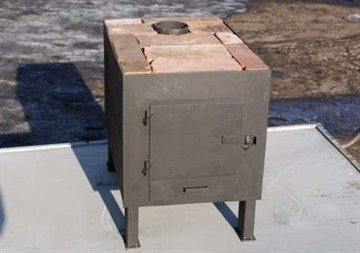

Minimum distance from the hog to building structures without heat-resistant plaster:
Last of all, the doors of the firebox and the blower are hung.
In order to ensure fire safety and increase the efficiency of the furnace (so that heat does not go into the floor), it is placed on a sheet of tin with a 6 mm substrate made of asbestos or basalt or kaolin cardboard (unlike the first, they do not harm health). The sheet extends beyond the contours of the furnace by at least 350 mm in each direction (ideally - 600 mm).
Sauna stoves and their features
If necessary, a stove for a bath with a heating circuit can be quite versatile both in terms of operating mode and in terms of the fuel used in it. Such a furnace can be used either in the mode of continuous fuel combustion, or in a cyclic mode, with periodic loading of combustible material. Natural gas, wood, charcoal or fuel pellets can be used as fuel.In addition, electric ovens of appropriate power can also be used to heat the bath and heat water.
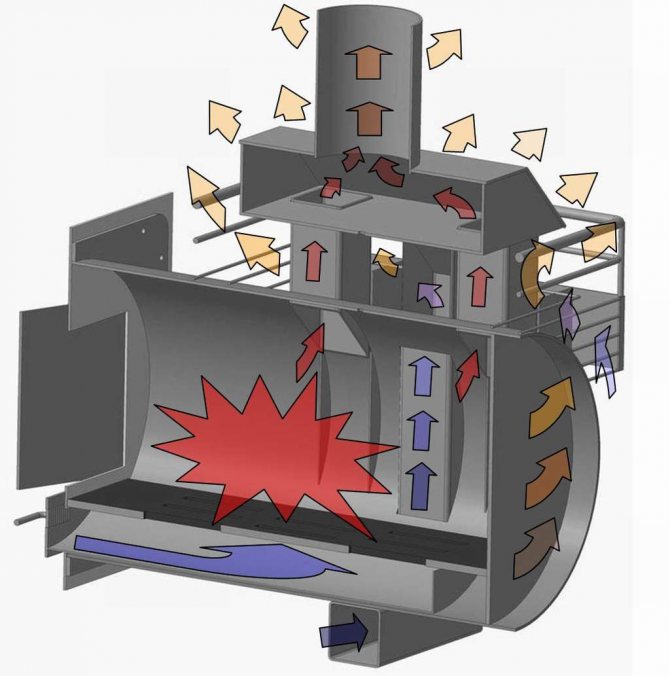

For the manufacture of continuous combustion furnaces, steel is usually used. Such a furnace heats up quickly and cools down quickly when the fuel is stopped. Sometimes the surface of steel stoves is lined with decorative non-combustible material, which increases its safety and heat capacity.
Furnaces used in a cyclic room heating mode must have a high heat capacity and the ability to retain heat for a long time after the fuel supply stops. They are made from refractory bricks, which have a large mass and high heat capacity. Such an oven, after heating, can maintain a high temperature for a sufficiently long time. The disadvantages of such furnaces include a long time to reach the operating mode, that is, a long time for heating the furnace in a cold state.
To organize the supply of hot water to the bath, as well as to heat the premises, furnaces equipped with forced circulation of hot water systems, as well as heat exchangers, are used.

